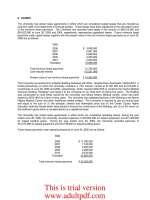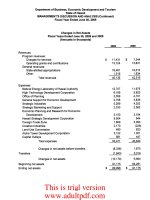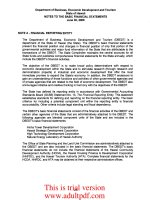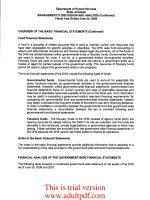NISHIHAMA & KISHIDA, CPAs, INC. CERTIFIED PUBLIC ACCOUNTANTS FINANCIAL AUDIT OF THE DEPARTMENT OF EDUCATION STATE OF HAWAII Fiscal Year Ended June 30, 2005_part4 potx
Bạn đang xem bản rút gọn của tài liệu. Xem và tải ngay bản đầy đủ của tài liệu tại đây (358.27 KB, 10 trang )
Department
of
Education
State
of
Hawaii
NOTES TO THE BASIC FINANCIAL STATEMENTS
June
30, 2005
NOTE C • BUDGETING AND BUDGETARY CONTROL
Revenue estimates are provided to the State Legislature at the time
of
budget consideration
and are revised and updated periodically during the fiscal year. Amounts reflected as
budgeted revenues and budgeted expenditures
in
the budgetary comparison schedules
of
the
general and special revenue funds are derived primarily from acts
of
the State Legislature and
from other authorizations contained
in
other specific appropriation acts
in
various Session
Laws
of
Hawaii.
To the extent not expended or encumbered, general fund appropriations generally lapse at the
end
of
the fiscal year for which the appropriations were made. The State Legislature specifies
the lapse date and any other particular conditions relating to terminating the authorization for
other appropriations such as those related to the special revenue funds.
Section 37-41.5
of
the Hawaii Revised Statutes allows the DOE to carryover up to five percent
each
of
any appropriation at the end
of
the fiscal year except for appropriations to fund certain
financing agreements. These carryover funds, to the extent not expended
or
encumbered,
lapse at June 30
of
the first fiscal year
of
the next fiscal biennium. As
of
June 30, 2005,
general funds carried over amounted to approximately $30,800,000.
For purposes
of
budgeting, the DOE's budgetary fund structure and accounting principles
differ from those utilized to present the fund financial statements
in
conformity with accounting
principles generally accepted
in
the United States
of
America (GAAP). The DOE's annual
budget is prepared on the modified accrual basis
of
accounting with several differences,
principally related to (1) the encumbrance
of
purchase orders and contract obligations, (2) the
recognition
of
certain receivables, and (3) special revenue funds operating grant accruals and
deferrals. These differences represent a departure from GAAP.
The following schedule reconciles the budgetary amounts to the amounts presented
in
accordance with GAAP for the fiscal year ended June 30, 2005.
Excess (deficiency)
of
revenues over expendi-
tures and other uses - actual
on
a
budgetary basis
Reserved for encumbrances at fiscal year-
end
Expenditures for liquidation
of
prior fiscal
year encumbrances
Net change
in
unreserved liabilities
Accrual adjustments related to federal reim-
bursements for program expenditures
Revenues for unbudgeted programs
Excess (deficiency)
of
revenues over expendi-
tures and other uses - GAAP basis
31
General
$ 16,592,772
37,101,100
(37,279,670)
(5,731,804)
$ 10.682.398
Federal
$
(4,770,882)
10,900,742
(12,330,501)
1,162,664
(5,147,219)
237,330
$
(9.947.866)
This is trial version
www.adultpdf.com
Department
of
Education
State
of
Hawaii
NOTES TO THE BASIC FINANCIAL STATEMENTS
June
30, 2005
NOTE D - CASH AND CASH EQUIVALENTS
Substantially all
of
the DOE's cash and certificates of deposit are held
in
the State Treasury.
The State Director
of
Finance
is
responsible for safekeeping
of
all monies paid into the State
Treasury. The State Director
of
Finance pools and invests any monies
in
excess of the
amounts necessary for meeting specific requirements
of
the State. The Hawaii Revised
Statutes authorize the State Director
of
Finance
to
invest
in
obligations of, or guaranteed
by,
the
U.S.
Government, obligations
of
the State, federally-insured savings and checking
accounts, time certificates
of
deposit, and repurchase agreements with federally-insured
financial institutions.
Information relating to custodial credit risk of cash deposits and interest rate risk, credit risk,
custodial risk, and concentration of credit risk
of
investments
in
the State Treasury
is
available
on a statewide basis and not for individual departments or agencies.
Custodial
credit
risk
Cash and deposits with financial institutions are collateralized
in
accordance with State
statutes. All securities pledged as collateral are held either by the State Treasury or by the
State's fiscal agents
in
the name
of
the State.
The DOE also maintains cash
in
banks which are held separately from cash
in
the State
Treasury. As
of
June
30,
2005, the carrying amount
of
total bank deposits was approximately
$6,259,000 and the corresponding bank balances which are represented were approximately
$5,911,000.
Of
this amount, approximately $2,596,000
is
insured by the Federal Deposit
Insurance Corporation and collateralized with securities held by the DOE's agent. The uninsured
and uncollaterized balance at June 30,2005, was approximately $3,315,000.
Interest rate
risk
As a means
of
limiting its exposure to fair value losses arising from rising interest rates, the
State's investment policy generally limits maturities
on
investments to not more than five years
from the date of investment.
Credit
risk
The State's investment policy limits investments
in
state and U.S. Treasury securities, time
certificates
of
deposit, U.S. government or agency obligations, repurchase agreements,
commercial paper, bankers' acceptances, and money market funds and student loan resource
securities maintaining a Triple-A rating. As
of
June 30, 2005, the State held short-term
investments
in
student loan resource securities maintaining a Triple-A rating.
Custodial
risk
For
an
investment, custodial risk
is
the risk that,
in
the event
of
the failure
of
the counterparty,
the State will not be able to recover the value
of
its investments or collateral securities that are
in
the possession
of
an
outside party. The State's investments are held at broker/dealer firms
which are protected by the Securities Investor Protection Corporation (SIPC) up to a maximum
amount.
In
addition, excess-SIPC coverage
is
provided by the firms' insurance policies.
In
addition, the State requires the institutions to set aside
in
safekeeping, certain
32
This is trial version
www.adultpdf.com
Department
of
Education
State
of
Hawaii
NOTES
TO
THE BASIC FINANCIAL STATEMENTS
June 30, 2005
NOTE D - CASH AND CASH EQUIVALENTS (Continued)
types
of
securities to collateralize repurchase agreements. The State monitors the market
value
of
these securities and obtains additional collateral when appropriate.
Concentration
of
credit risk
The State's policy provides guidelines for portfolio diversification by placing limits on the
amount the State may invest
in
anyone
issuer, types
of
investment instruments, and position
limits per issue
of
an investment instrument.
NOTE E - CAPITAL ASSETS
The changes
in
capital assets were as follows:
Governmental
activities
Capital
asset,
not
being
depreciated
Land
Land
improvements
Total
capital
assets
not
being
depreciated
Capital
assets,
being
depreciated
Land
improvements
Building
and
improvements
Furniture
and
equipment
Public
library
materials
Total
capital
assets
being
depreciated
Less
accumulated
depreciation
for:
Land
improvements
Building
and
improvements
Furniture
and
equipment
Public
library
materials
Total
accumulated
depreciation
Balance
July
1,
2004
$
61,246,260
$
5,781,281
67,027,541
65,176,804
1,366,892,468
57,955,464
57,152,588
1,547,177,324
47,727,326
668,010,247
41,868,282
46,580,002
804,185,857
Additions
888,332
35,860,576
9,347,878
9,990,789
56,087,575
2,922,164
44,605,762
5,533,655
4,631,797
57,693,378
$
Deductions
1,960,694
1,960,694
1,470,356
1,470,356
Balance
June
30,
2005
$
61,246,260
5,781,281
67,027,541
66,065,136
1,402,753,044
65,342,648
67,143,377
1,601,304,205
50,649,490
712,616,009
45,931,581
51,211,799
860,408,879
Governmental
activities,
net
$
810,019,008
$
(1,605,803)
$
33
490,338
$
807,922,867
This is trial version
www.adultpdf.com
Department
of
Education
State
of
Hawaii
NOTES TO THE BASIC FINANCIAL STATEMENTS
June 30, 2005
NOTE E - CAPITAL ASSETS (Continued)
Depreciation expense was charged to functions as follows:
Governmental
Activities
School level instruction
Instructional support
State and district administration
School support
School community service
Public libraries
Other
Total depreciation expense
NOTE F - LONG-TERM LIABILITIES
$ 49,687,925
689,110
585,911
1,503,806
63,050
5,157,354
6,222
$ 57,693,378
The change
in
the long-term liabilities during the fiscal year ended June 30, 2005, was as
follows:
Accrued Workers'
Compensated Compensation
Absences
Claims
Balance at July
1,
2004
$
39,900,188
$
35,291,024
Additions
12,887,795 19,320,614
Reductions
(7,781 ,935)
(9,348,570)
Balance at June 30, 2005
$
45,006,048
$
45,263,068
Due within one year
$
6,542,009
$
12,849,800
The compensated absences and workers' compensation liabilities have been paid primarily by
the general fund
in
the past.
34
This is trial version
www.adultpdf.com
Department
of
Education
State
of
Hawaii
NOTES TO THE BASIC FINANCIAL STATEMENTS
June 30, 2005
NOTE G • FUND BALANCES
Reserved for Encumbrances
Reserved for encumbrances represents the portion
of
the fund balance that
is
segregated
for expenditure
on
vendor performance.
Reserved for Continuing Appropriations
Reserved for continuing appropriations represents unencumbered allotment balances that
have been released and made available for encumbrance or expenditure and are legally
segregated for a specific future use.
Fund Balance Deficit
The general fund and capital project fund
had
a deficit balance
in
the unreserved fund
balance at June
30, 2005,
of
$79,835,675 and $37,861,481, respectively. The deficits
resulted primarily from expenditures being recorded
on
the accrual basis when incurred, and
revenues being recognized only when funds are measurable and available.
NOTE H • CHANGES IN ASSETS AND LIABILITIES OF THE AGENCY FUNDS
The agency funds are purely custodial (assets equal liabilities) and thus do not involve the
measurement
of
results of operations. The changes
in
assets and liabilities of the agency
funds for the fiscal year ended June
30, 2005, were as follows:
ASSETS
Balance
July
1,
2004
Additions
Balance
Deductions June
30,2005
Cash and other assets
held
in
trust
LIABILITIES
Due
to
student groups
and others
$ 14.368.813 $ 28.544,985 $ 25.505.538 $ 17.408.260
$ 14.368.813 $ 28,544,985 $ 25.505.538 $ 17.408.260
35
This is trial version
www.adultpdf.com
Department
of
Education
State
of
Hawaii
NOTES TO THE BASIC FINANCIAL STATEMENTS
June
30, 2005
NOTE I - LEASE COMMITMENTS
The DOE leases equipment from third party lessors under various operating leases expiring
through 2011. Future minimum lease rentals under non-cancelable operating leases with
terms of one year or more at June
30,
2005, were
as
follows:
Fiscal Year Ending June 30,
2006
2007
2008
2009
2010
2011
Amount
$ 2,993,000
2,676,000
1,938,000
1,055,000
312,000
13,000
$ 8.987.000
Total rent expense related to the above leases for the fiscal year ended June
30,
2005,
amounted to approximately $3,016,000.
NOTE J - RETIREMENT BENEFITS
Employees' Retirement System
Substantially all eligible employees
of
the DOE are required by Chapter
88,
Hawaii Revised
Statutes (HRS), to become members of the Employees' Retirement System of the State of
Hawaii (ERS), a cost-sharing multiple-employer public employee retirement plan. The ERS
provides retirement benefits
as
well as death and disability benefits. The ERS issues a
publicly available financial report that includes financial statements and required
supplementary information. The report may
be
obtained by writing to the ERS at City Financial
Tower,
201
Merchant Street, Suite 1400, Honolulu, Hawaii 96813.
Members
of
the ERS belong to either a contributory or noncontributory option. Only
employees of the DOE hired
on
or before June
30,
1984 are eligible to participate
in
the
contributory option. Members are required by state statue to contribute 7.8% of their salary to
the contributory option and the DOE
is
required to contribute to both options at
an
actuarially
determined rate. The portion of the contributions related to DOE's general and special
revenue funds are recorded
as
an expenditure
of
the respective funds
in
the financial
statements. Contributions by the DOE for the fiscal year ended June
30,
2005, 2004, and
2003, were approximately $92,159,000, $90,892,000, and $84,364,000. The contribution
rates for the fiscal years ended June 30, 2005, 2004, and 2003, were 9.14%, 8.87%, and
8.87%, respectively.
36
This is trial version
www.adultpdf.com
Department
of
Education
State
of
Hawaii
NOTES TO THE BASIC FINANCIAL STATEMENTS
June 30, 2005
NOTE J - RETIREMENT BENEFITS (Continued)
Post-Retirement Health Care and Life Insurance Benefits
In
addition to providing pension benefits, the State, pursuant to Section
87
A of the Hawaii
Revised Statutes, provides certain health care and life insurance benefits to retired state
employees. Contributions are financed
on
a pay-as-you-go basis. The DOE's general fund
and special revenue fund share of the expense for post-retirement health care and life
insurance benefits for the fiscal year ended June 30, 2005, was approximately $66,587,000
and $4,599,000, respectively, and
is
included
in
the basic financial statements.
Deferred Compensation Plan
The State offers its employees a deferred compensation plan created
in
accordance with
Internal Revenue Code Section 457. The plan, available to all state employees, permits
employees to defer a portion of their salary until future years. The deferred compensation is
not available to employees until termination, retirement, death, or unforeseeable emergency.
All plan assets are held
in
a trust fund to protect them from claims of general creditors. The
State has
no
responsibility for loss due to the investment or failure
of
investment of funds and
assets
in
the plan, but does have the duty of due care that would be required of an ordinary
prudent investor. Accordingly, the assets and liabilities of the State's deferred compensation
plan are not reported
in
the State's or DOE's basic financial statements.
NOTE K - RISK MANAGEMENT
The DOE
is
exposed to various risks of loss related to torts; theft
of,
damage to, or destruction
of
assets; errors or omissions; and workers' compensation. The State generally
is
at risk for
the first $250,000 per occurrence of property losses and the first $3 million with respect to
general liability claims. Losses
in
excess of those retention amounts are insured with
commercial insurance carriers. The limit per occurrence for property losses
is
$100 million
($25 million for earthquake, named hurricane and flood) and the annual aggregate for general
liability losses per occurrence
is
$10 million. The State also has an insurance policy to cover
medical malpractice risk
in
the amount of $20 million per occurrence with no annual aggregate
limit. The State
is
generally self-insured for automobile claims.
The DOE
is
self-insured for workers' compensation and automobile claims. The DOE's
estimated reserve for losses and loss adjustment costs include the accumulation of estimates
for losses and claims reported prior to fiscal year-end, estimates (based on projections of
historical developments) of claims incurred but not reported, and estimates of costs for
investigating and adjusting
all
incurred and unadjusted claims. Amounts reported are subject
to the impact of future changes
in
economic and social conditions. The DOE believes that,
given the inherent variability
in
any such estimates, the reserves are within a reasonable and
acceptable range of adequacy. Reserves are continually monitored and reviewed, and as
settlements are made and reserves adjusted, the differences are reported
in
current
operations. A liability for a claim
is
established if information indicates that it
is
probable that a
liability has been incurred at the date of the basic financial statements and the amount of the
loss
is
reasonably estimable.
37
This is trial version
www.adultpdf.com
Department
of
Education
State
of
Hawaii
NOTES TO THE BASIC FINANCIAL STATEMENTS
June
30,
2005
NOTE L • COMMITMENTS AND CONTINGENCIES
Accumulated Sick Leave
Employees earn sick leave credits at the rate of one
and
three-quarters working days for each
month of service without limit, but
can
be
taken only
in
the event of illness
and
is not
convertible to pay upon termination of employment. However, a public employee who retires
or leaves government service
in
good standing with sixty days or more of unused sick leave
is
entitled
to
additional service credit
in
the
ERS.
Accumulated sick leave
as
of June
30,
2005,
amounted to approximately $530,084,000.
Litigation
The
DOE
is
a party
to
various legal proceedings. Although the DOE
and
its counsel are
unable to express opinions
as
to
the outcome of the litigation, it
is
their opinion that any
potential liability arising therefrom will not have a material adverse effect
on
the financial
position of the DOE because any judgments against the DOE are judgments against the State
and would
be
paid by legislative appropriation of the State General Fund
and
not
by
the
DOE.
NOTE M • FOOD DISTRIBUTION PROGRAM
The DOE receives food commodities from the U.S. Department of
AgriCUlture,
Food and
Nutrition Service (FNS), under the Federal Food Distribution Program. The DOE School
Food Services Branch distributes the food to qualifying schools, charitable organizations,
and nonprofit summer camps for children. The total value
of
the amount of food which the
DOE is entitled to receive
is
determined
in
part by the number of meals served under the
National School Lunch Program. The DOE's allocation balance
is
reduced as the DOE
receive the food commodities. The amount charged to the DOE allocation balance is based
upon the FNS's cost to purchase the commodities. The bonus commodities do not reduce
the DOE's allocation balance.
The following
is
a summary
of
the value of the food commodities received by the DOE
during the fiscal year ended June
30,
2005. The value of the bonus commodities is based
upon the estimated costs provided by the FNS
in
the Current Commodity File report dated
June 30, 2005.
Amount
Basic allocation
Bonus commodities
38
$ 2,441,447
475,169
$ 2.916,616
This is trial version
www.adultpdf.com
SUPPLEMENTARY INFORMATION
39
This is trial version
www.adultpdf.com
Department
of
Education
State
of
Hawaii
SCHEDULE
OF
EXPENDITURES
OF
FEDERAL AWARDS
Fiscal Year Ended
June
30, 2005
Federal
Pass-Through
Amount
CFDA
Entity
Identifying
Federal
Provided
to
Federal
Grantor/Pass-through
Grantor
and
Program
Title
Number
Number
Expenditures
1
Subrecipient
U.S.
Department
of
Agriculture
Food
Donation
2
10.550
$
2,916,616
$
Child
Nutrition
Cluster:
School
Breakfast
Program
10.553
6,668,245
302,855
National
School
Lunch
Program
10.555
32,880,872
1,000,843
Special
Milk
Program
for
Children
10.556
9,698
9,698
Summer
Food
Service
Program
for
Children
10.559
773,455
773,455
Child
and
Adult
Care
Food
Program
10.558
4,982,040 4,982,040
State
Administrative
Expenses
10.560
679,919
Total
U.S.
Department
of Agriculture
48,910,845
7,068,891
U.S.
Department
of
Defense
National
Defense
Authorization
Act
P.L.
102-484
N/A
3
1,276,708
Troops
To
Teachers
-
DOD
FY04
N/A
3
41,550
Troops
To
Teachers
-
DOD
FY05
N/A
3
8,316
Passed-through
State
Department
of
Defense
Joint
Venture
Education
Forum
N/A
3
2,997,946
Total
U.S.
Department
of
Defense
4,324,520
National
Oceanic
and
Atmospheric
Administration
Coastal
Services
Center
11.473
2,390
Total
National
Oceanic
and
Atmospheric
Administration
$
2,390
$
40
This is trial version
www.adultpdf.com









